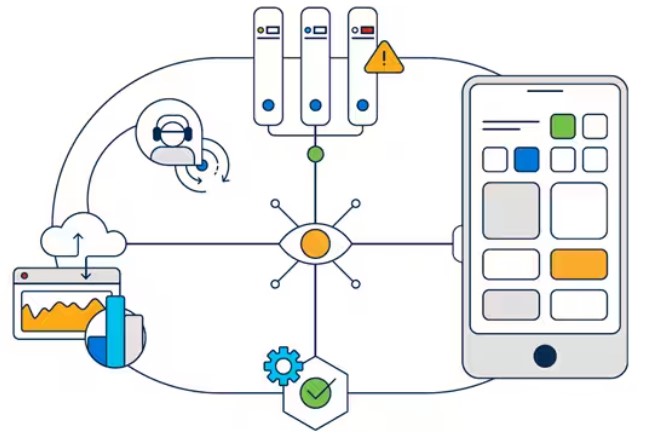What Is Full-Stack Observability?
July 25, 2023 •Network Solutions

Full-stack observability is a comprehensive approach to monitoring and understanding the performance, behavior, and health of an entire software application or system stack. It involves the collection, analysis, and visualization of data from various sources throughout the stack, including application code, infrastructure, and user interactions. The goal of full-stack observability is to provide developers, operations teams, and other stakeholders with deep insights into how the system is functioning, enabling them to identify and address issues proactively and improve overall system performance and reliability.
Key components of full-stack observability typically include:
-
Logging: Collecting and analyzing log data from various components in the application stack. Logs contain valuable information about events, errors, and activities, which helps in troubleshooting and identifying potential problems.
-
Metrics: Capturing and monitoring various performance metrics such as CPU usage, memory utilization, network traffic, request rates, and latency. Metrics give a high-level view of system health and performance trends.
-
Tracing: Tracing follows the path of a specific transaction or request as it moves through the system, capturing data about each component it interacts with. This helps in identifying performance bottlenecks and understanding the flow of execution.
-
Distributed Tracing: A specific type of tracing that is useful in distributed systems where transactions span multiple services or microservices. It provides visibility into how requests flow through the entire system, making it easier to pinpoint latency issues and dependencies.
-
Monitoring Infrastructure: Observing the health and performance of the underlying infrastructure, including servers, databases, networking components, and cloud services.
-
AIOps (Artificial Intelligence for IT Operations): Employing machine learning and artificial intelligence algorithms to analyze large amounts of data and detect anomalies automatically. This aids in identifying issues or unusual patterns that might be missed with traditional monitoring methods.
-
Visualization and Dashboards: Presenting the collected data in a user-friendly manner through various charts, graphs, and dashboards. This allows stakeholders to quickly understand the state of the system and spot trends or abnormalities.
Full-stack observability is becoming increasingly important as modern applications are often composed of multiple microservices running on different platforms and environments. With this approach, developers and operations teams can gain a holistic view of their systems, allowing them to respond faster to issues, optimize performance, and ultimately enhance the user experience.
Full-stack observability is crucial for effectively managing and monitoring complex software systems and applications. It involves the collection, analysis, and visualization of data from all layers of the technology stack, including infrastructure, application code, and user interactions. Here are some key reasons why using full-stack observability is essential:
-
Comprehensive insights: Full-stack observability provides a holistic view of your entire system, enabling you to understand how different components and services interact with each other. This visibility helps identify potential issues and bottlenecks that might not be apparent when looking at individual components in isolation.
-
Faster problem identification and resolution: When an issue arises, full-stack observability allows you to quickly pinpoint the root cause by examining all relevant data points from various layers. This reduces the time spent on debugging and troubleshooting, leading to faster problem resolution and improved system reliability.
-
Proactive monitoring: Instead of reacting to problems after they occur, full-stack observability allows you to proactively monitor system metrics, performance, and user experience. You can set up alerts and triggers to detect anomalies or unusual patterns, enabling you to address potential issues before they escalate.
-
Improved collaboration: Full-stack observability promotes better collaboration between different teams (e.g., development, operations, and support). All stakeholders can access the same set of data, speak the same language, and work together to resolve issues, fostering a more efficient and collaborative environment.
-
Enhanced user experience: By monitoring the full stack, you can gain insights into how users interact with your application and identify areas where improvements are needed. This can lead to a better user experience, increased customer satisfaction, and potentially higher retention rates.
-
Capacity planning and optimization: Full-stack observability provides data on resource utilization, system performance, and application behavior. This information is invaluable for capacity planning, resource optimization, and scaling your infrastructure to handle increasing demands.
-
Compliance and auditing: In some industries, compliance and auditing requirements necessitate comprehensive monitoring and tracking of system activities. Full-stack observability ensures that you have the necessary data to meet these regulatory standards.
-
Future-proofing your system: As your application evolves and new technologies emerge, full-stack observability ensures that you can adapt and monitor these changes effectively. It enables you to keep pace with advancements and continuously improve your system's performance and reliability.
Conclusion
Overall, full-stack observability is an essential practice for modern software development and operations. It empowers organizations to deliver better-performing applications, identify and address issues quickly, and ensure a positive user experience in an ever-changing technological landscape.
To learn even more about full-stack observability or any other business technology solution, talk with our experts at Network Solutions!
Get Updates
Featured Articles
Categories
- AI (15)
- Automated Technology (8)
- backup (1)
- Cisco (26)
- Cisco Live Update (1)
- Cisco News (2)
- Cisco UCS (1)
- Cloud Networking (4)
- Collaboration (25)
- compute (1)
- CyberSecurity (29)
- Data Center (32)
- DevOps (3)
- DisasterRecovery (1)
- DNA (2)
- Education (3)
- Encryption (1)
- Enterprise Networking (31)
- Full-Stack (1)
- Future (1)
- healthcare (2)
- hybrid cloud (1)
- Innovative Technology (11)
- Internet of Things (2)
- IoT (1)
- Managed Services (10)
- Modern Data Center (2)
- Monitoring (1)
- Network Management (4)
- Networking (2)
- nutanix (1)
- Observability (1)
- Ransomware (2)
- SchoolTechnology (6)
- SD-WAN (1)
- SDN (1)
- securit (1)
- Security (68)
- security management (1)
- security strategy (6)
- SSE (1)
- sustainability (1)
- Telehealth (3)
- veeam (1)
- Video (1)
- Virtualization (2)
- webex (2)
- XDR (1)
- Zero Trust (8)



